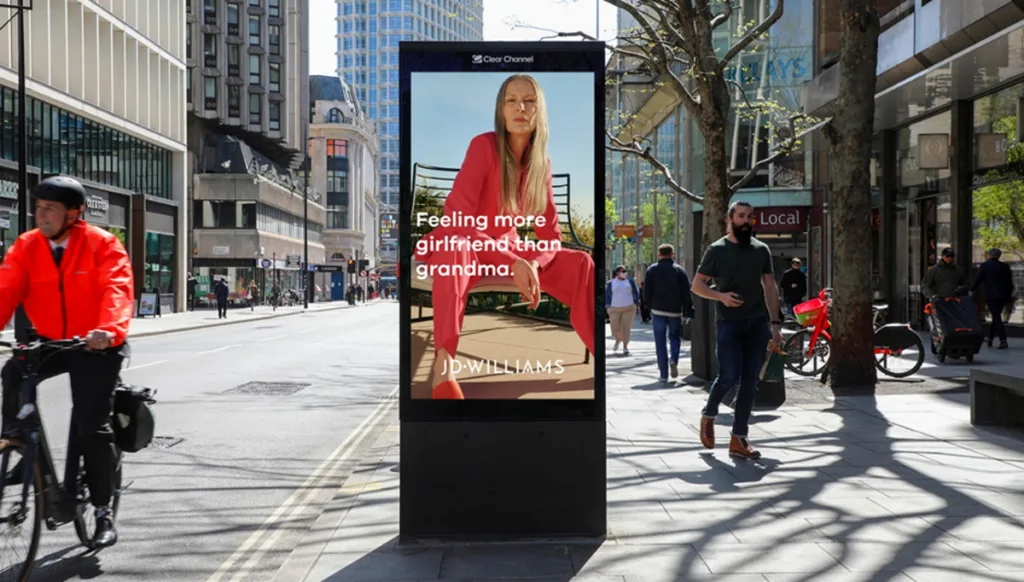By Natalie Hollands, Client Partner for Retail & TechCo at Clear Channel UK
As marketers and advertisers our role is to understand, reflect and effectively communicate to a society which by definition is diverse. This is exactly why inclusion and representation should be top of the agenda for the entire media industry: brands, agencies and media owners alike. Playing lip service to this topic is simply no longer an option as consumers are waking up to social injustice and demanding action, which is impacting their brand choices.
According to research from ISBA, seven in ten UK adults say it’s important for different groups in society to be well represented in advertising. And yet the proportion of male to female characters on our screens still remains broadly unchanged at 60:40, even in 2023.
Misrepresentation of midlife women
One brand looking to tackle misrepresentation head on is fashion retailer, JD Williams. “For too long, midlife women have been underrepresented by the fashion and beauty industry”, states Esme Stone, Head of Brand at JD Williams, which is why its latest campaign is committing to “changing the narrative around ‘midlife’ by representing women at this life stage”.
Whilst I might not be at the targeted ‘midlife’ stage quite yet, I’m one of far too many women who can’t help but be frustrated by the lack of, or often worse, complete misrepresentation of older females we’ve seen in the retail space over the years, particularly highlighted by advertising. And no, I’m not referring to the “Your wife would LOVE a vacuum for Christmas” ads from the 50s & 60s.
The reality is that this group remains a large sub-section of the population who feel totally ignored by brands, only exacerbated in the fashion and beauty sector. Parent company of JD Williams, N Brown Group, found in their own 2021 ‘Womankind’ survey that a massive “70% of women aged 45-plus do not feel understood or valued by fashion retailers”.
Applying the Clear Channel “Powerful Posters” lens, this campaign delivers everything that a great brand message in Out-of-Home (OOH) should – it’s bold, bright, simple (and a little on the cheeky side). But more than that, it cuts right to the issue. It demonstrates a brand who understands the problem and has listened to their audience, which should reap rewards. Latest industry research into representation in advertising found that delivering a more inclusive message saw purchase intent increase by 26% amongst audiences 35+ (vs non-inclusive designs)*.

Tackling dangerous stereotypes
Another powerful example of using advertising to tackle misrepresentation is the ’56 Black Men’ campaign founded and created by Cephas Williams. The campaign looks to challenge the dangerous and negative stereotypes of Black men wearing hoodies often portrayed in mainstream media.
The campaign looks to challenge the dangerous stereotype of ‘the Black man’ and the negative connotations attached to the cliché image of a Black man wearing a hoody.
The tagline of the striking photography series is “I am not my stereotype”, boldly displayed alongside the 56 portraits of black men all wearing the same black hoody. Among the men photographed are Sky’s football presenter Samuel Obaseki, business managers, fathers, writers, electricians, Uber drivers, actors, and of course, Tottenham MP David Lammy.
Utilising the power and scale of Clear Channel’s digital Out of Home portfolio, the message was amplified across the length and breadth of the UK. Adding to the momentum and impact of the campaign, social media posts of the posters appeared from London, Glasgow, Manchester and beyond.
Leveraging the power of OOH
Both campaigns are powerful examples of brands using their voice to challenge stereotypes and stigmas that groups within society face every day, and amplifying these calls by leveraging OOH’s superpower of mass reach and being in the real-world.
And this idea of a “collective understanding” is a hot topic at Clear Channel right now, as we’re working with the idea of cultural imprinting, which refers to the notion that an advert needs to make an individual feel that they’re buying into an attitude that is shared by a collective. Because, after all, Out of Home is THE Inclusive Channel; a public, trusted, real-world medium that by its very nature is designed for all. A Platform for Brands and a Platform for Good.
*Real World Research (Kinetic et al, 2021)







